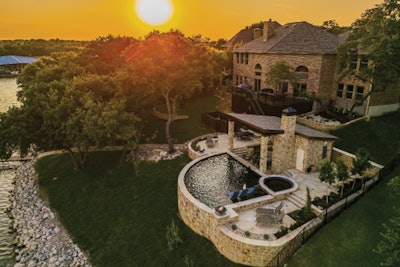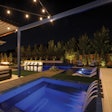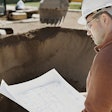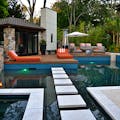
One of the most frequent questions clients ask is, “Where do we even start?”
For an experienced designer, that question is the gateway. It’s the moment when vision, creativity, and intuition begin to shape the journey ahead. It’s where the design process transforms from abstract ideas into a living, breathing plan.
Designing outdoor spaces, landscapes, and pools is about far more than appearances. At its heart, it’s about evoking a feeling — capturing a memory, a mood, or a sensory experience, and weaving it into a space you can live in.
We should always start by looking inward to find inspiration. Whether it’s the peaceful ambiance of a resort pool, the joy of summer evenings around a long dining table, or the quiet comfort of strolling barefoot through a garden at dusk, those emotional cues become the foundation of thoughtful design.
The role of a great designer is to uncover those feelings and personal memories, and then bring them to life through space, form, texture and flow. By taking into account the client’s lifestyle, the home’s architecture, and the land’s character, a deeply personal outdoor environment begins to emerge.
Because ultimately, great design isn’t just about where you place a pool or what plants you pick — it’s about creating a space that feels like home… outside. A place not only to be admired but truly lived in.
Here are five pro design tips that are essential in the design process to bring a vision from inspiration to reality.
 A well-designed backyard is an experience you look forward to having, again and again.Photo courtesy Kirk Bianchi, Bianchi Design
A well-designed backyard is an experience you look forward to having, again and again.Photo courtesy Kirk Bianchi, Bianchi Design
TIP ONE: FROM INSPIRATION TO INTENTION
Inspiration isn’t about endless scrolling through Pinterest or Instagram. It goes deeper. A thoughtful designer guides clients inward, helping them reflect on what truly resonates.
What memories linger most vividly? Was it the quiet ripple of water at a boutique hotel? The scent of lavender spilling over a stone path at a grandparent’s home? These aren’t just sentimental recollections — they’re powerful clues. They shape the design’s mood, palette and materials.
The land itself speaks, too. The way light shifts through the day, how wind dances through the yard, the texture and tone of local stone and soil — all of it informs the design. Pulling in natural hues — sun-bleached neutrals, earthy greens, or vibrant accents from native flora — helps the space feel organic and timeless, as if it’s always belonged.
And then there’s the architecture of the home. Outdoor spaces shouldn’t feel like an afterthought. A welldesigned exterior flows seamlessly from the interior. Whether the home is sleek and modern or warm and earthy, a designer ensures the outdoor experience complements and elevates what already exists.
TIP TWO: DESIGN WITH PURPOSE AND PRECISION
Once inspiration is clarified, vision becomes action.
The process begins by defining a design palette — a harmony of colors, tones, and textures that reflect the mood of the space. Whether the desired feel is luxurious and quiet, bold and playful, or simple and serene, this palette becomes the anchor for every decision.
Texture is layered with intention. Smooth surfaces meet rugged edges. Cool stone contrasts with warm wood. Matte finishes play against reflective elements. These details aren’t just aesthetic — they engage the senses. The warmth of a sun-heated paver under bare feet. The grain of aged wood under your palm. The crunch of gravel underfoot during an evening stroll.
Every design choice contributes to a cohesive whole, building depth and story into the space.
TIP THREE: BRINGING THE VISION TO LIFE
This is the phase where imagination meets craftsmanship — and where a skilled designer becomes an essential partner.
It begins with a master plan, even if the project unfolds in stages. A well-developed plan ensures visual consistency, avoids expensive mistakes, and keeps the overall vision intact. From pool placement to the way lighting enhances a pathway, every detail matters.
Clients are encouraged to experience the materials firsthand. Feel the textures. Observe the light throughout the day. Live with the options before committing. A material that looks perfect at noon may feel entirely different under the glow of evening lights.
Quality is key. The most successful outdoor spaces aren’t just beautiful on day one — they grow more graceful over time. Designers steer clients toward materials that weather well, mature beautifully, and harmonize with nature. Teak that silvers with age, stone that gains character, plants that thrive and become architectural features — these are the markers of a space built for longevity.
 A thoughtful designer guides clients inward, helping them reflect on what truly resonates.Photo courtesy Mike Farley, Claffey Pools
A thoughtful designer guides clients inward, helping them reflect on what truly resonates.Photo courtesy Mike Farley, Claffey Pools
TIP FOUR: FOCUS ON THE EXPERIENCE, NOT JUST THE LOOK
This is the part people often overlook. A great outdoor space isn’t just about how it looks — it’s about how it feels to be in it.
A backyard should make life easier, not more complicated. It should be a place where you actually want to have your morning coffee, where a casual get-together with friends doesn’t feel like a hassle, where you can relax without feeling like you’re in a staged showroom.
It’s about those simple, everyday moments — grilling dinner without feeling cramped, sitting outside on a cool evening without needing to drag out extra chairs, letting the kids run around without worrying about them trampling something fragile.
When a space is designed around how you actually live, everything just works.
TIP FIVE: SPACES THAT FEEL LIKE HOME
At the end of the day, designing an outdoor space isn’t about making it look picture-perfect. It’s about making it fit your life.
It’s about creating a space that makes it easy to invite people over without stressing. It’s about having a spot to relax at the end of the day without feeling like you’re supposed to be doing something productive. It’s about making your home feel bigger — because suddenly, your outdoor space isn’t just sitting there, unused. It’s part of your everyday life.
So, if you’re wondering where to start, start with that. What do you actually want from your space? What would make you want to be outside more?
Once you figure that out, the rest is just details.
This article first appeared in the June 2025 issue of AQUA Magazine — the top resource for retailers, builders and service pros in the pool and spa industry. Subscriptions to the print magazine are free to all industry professionals. Click here to subscribe.










































